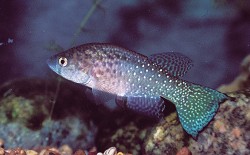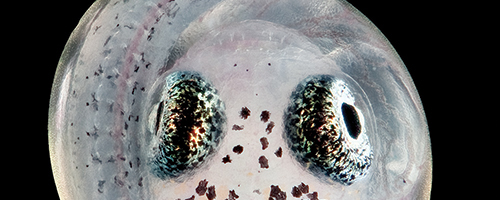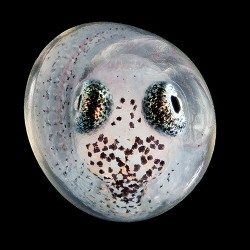There is a creature that can survive without oxygen. It can live for weeks without water.
Life in the extreme
There is a creature that can survive without oxygen. It can live for weeks without water.
It stops its own heart for months at a time, and starts it up again without physical repercussions.
This organism could be an evolutionary key to helping humans survive life-threatening illnesses.
To hear it described, one might envision something out of a superhero comic—an indestructible mutant or a genetically advanced alien. A being that is larger than life.
In reality, it’s a fish embryo.
The annual killifish is a fish found in the deserts of Africa and South America. Yes, you read that right—deserts.
They live in small puddles and ponds that form after intense seasonal rains and are called an “annual” because they only live for one year. Once the ponds dry up, the adult fish die. Any spawned eggs are left in the hot, caking mud, where the embryos somehow survive without oxygen.

COURTESY OF jason Podrabsky
Adult killifish live in desert ponds and puddles that form after heavy rainfall. Jason Podrabsky studies their tolerences; his biology lab is a world resource for
Claire Riggs, a graduate student of biology at Portland State, studies the killifish’s tolerance for zero oxygen, a state called anoxia.
“As humans, we don’t do very well within a matter of minutes without oxygen,” Riggs said. “If we can learn some of [the killifish embryo’s] tricks, maybe that can be applied to help people survive heart attack or stroke.”
During development, killifish embryos go dormant when exposed to harsh conditions such as anoxia. They reduce their metabolism to base levels, put their cell development on pause, and can even stop their hearts for more than 90 days with no consequences.
If that mechanism could be developed in humans, it would be a major breakthrough for cancer therapy or reducing the damage caused by lack of oxygen during a heart attack
or stroke.
To determine how the killifish survives and, moreover, how it can start its heart back up without tissue damage, Riggs examines its microRNA.
“MicroRNA can suppress genes. The thinking is that maybe something is being suppressed during this metabolic dormancy,” Riggs said. By exposing killifish embryos to anoxia at different developmental stages, Riggs can examine the DNA and RNA (ribonucleic acid) of the embryo and see if there’s a change in the microRNA over time.
“The embryo has all these genes, and they aren’t all necessarily expressed,” Jason Podrabsky, Riggs’ advisor, said. “We’re interested in that nexus between the gene expression program that’s critical and essential for development, and how that gets altered by the environment.”
This reversible control of its metabolism is what makes the killifish unique among vertebrates and a potential biomedical treasure trove.
Podrabsky’s biology lab is currently the world resource for captive annual killifish.
Podrabsky personally collected a large population of killifish in Venezuela, and
maintains more than 60 breeding pairs that produce the embryos his students study.
His research on killifish began with an interest in how the environment affects development. While Riggs studies how killifish embryos can go dormant, Podrabsky and his other students study additional tolerances.
For example, killifish embryos can withstand being placed in liquid with a pH level of 2, the acidic equivalent of lemon juice. They can withstand high ultraviolet radiation and salinity twice that of seawater, and they can survive without water entirely by forming a “biological glass” around themselves to keep water inside their eggs.
“They become like little marbles,” Podrabsky said. “They even clink.”
Called cross-tolerance, it is possible that the killifish embryo’s resistance to life without oxygen has similar genetic mechanisms that allow it to thrive under additional adverse conditions.
“Tolerance to one thing ends up making you tolerant to another,” said Josiah Wagner, another graduate student studying the killifish and its grab bag of survival traits.
Podrabsky calls the killifish embryos “vertebrate extremophiles,” and believes that their developmental processes in the face of such severe environmental conditions could provide insights into how animals—including humans—might similarly alter development.
“All vertebrates share the same basic developmental mechanisms, so if we can understand how to alter development in a fish, it’s very likely we can apply that in some way to humans,” Podrabsky said.
Given that environmental conditions can affect developmental progression, the killifish embryos are an anomaly. Their developmental environment should kill them; instead they have established ways to thrive.
“The argument would be that evolution has already solved all of these problems. Maybe not for our lineage, but it has for this fish,” Podrabsky said. “If we can figure out how evolution solved it, then maybe we can mimic that in humans to alter people’s survival times and reduce damages.”
Though a practical application for humans is a long way off, Riggs’ research has garnered plenty of attention: She received a pre-doctoral fellowship from the National Science Foundation. This highly prestigious award will give Riggs three years of funding, allowing her to continue her research as she pursues her doctorate.
“Claire is so intelligent, and is really dedicated to using science for the betterment of the human condition; that’s what’s always driving her forward,” Podrabsky said.
While the answers to surviving anoxia may come from an embryo smaller than a pea, it is clear Riggs is onto something big.







